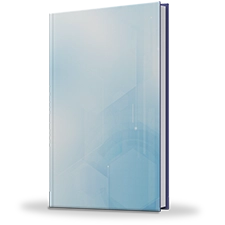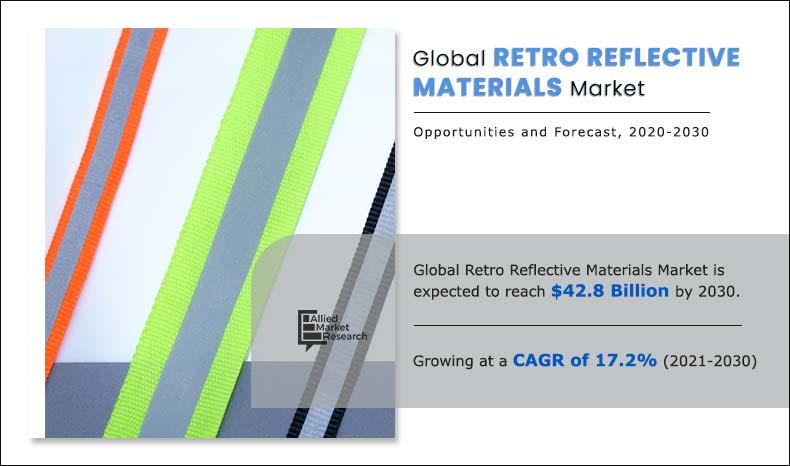Retro-Reflective Materials Market Statistics - 2030
The global retro-reflective material market size was valued at $8.6 billion in 2020, and is projected to reach $42.8 billion by 2030, growing at a CAGR of 17.2% from 2021 to 2030.
Retro-reflective material is composed of tiny glass beads that reflect light directly back toward its source at a wider angle than reflective material, owing to its ability to reflect incident energy back toward its source regardless of the direction of incidence. Retro-reflective materials are used to manufacture decorative heat transfer vinyl, high-end jackets, running gears, biking equipment, and professional safety uniforms such as reflective tape for clothing used for fire retardants. In addition, this material is used in sleeping tents and to increase scanning range of barcodes in factory settings.
Rise in tourism across the globe has strengthened the demand for riding equipment such as jackets and motorcycle designing, which is expected to drive growth of the retro-reflective material market in 2020. In addition, rapid increase in construction & infrastructure activities led to increase in use of sign boards and road color marking, which propels demand for retro-reflective materials. Moreover, retro-reflective material is highly used in marking in manufacturing parts of automotive and high security number plates, which, in turn, propels the retro-reflective material market growth.
The high manufacturing cost of retro-reflective materials compared to standard reflective products will further limit market expansion. Stringent government regulations concerning vehicle and personal safety, as well as technological advancements in retro-reflective technologies, are providing opportunities for the retro-reflective materials market. However, the worldwide retro-reflective materials market is challenged by the limited shelf life of retro-reflective products and a lack of knowledge about security products.
The retro reflective material market is segmented on the basis of technology type, product type, and application. On the basis of technology type, the retro reflective material market is segmented into ceramic beads, glass beads, and micro-prismatic. By product type, it is divided into films, sheets & tapes, paints & ink. By application, it is segmented into traffic control & work zone, safety apparel, automotive, industrials, and others. Region-wise, the retro reflective material market is studied across North America, Europe, Asia-Pacific, and LAMEA.
The key players operating in the global retro reflective material market are 3M, ALANOD GmbH & Co. KG, Avery Dennison, Changzhou Hua R Sheng Reflective Material, Coats Group Plc., Asian Paints PPG, Blueocean Solutions, Nanofuel Co. Ltd., Noritake Co. Ltd., and SulNOx Group Plc.
Global Retro Reflective Material Market, By Technology
By technology, the micro prismatic segment dominated the retro-reflective material market in 2020, and is projected to remain the fastest-growing segment during the forecast period. The use of this technology provides enhanced retro-reflectivity of materials. Increasing adoption of products that offer high degree of reflectivity, in order to enhance safety, is driving the demand for micro prismatic technology of the global retro reflective materials market.
By Type
Microprismatic is projected as the most lucrative segment.
Global Retro Reflective Material Market, By Product Type
By product type, the films, sheets & tapes segment accounted for the highest market share of around 45.5% in 2020, and is projected to maintain the same during the retro reflective material market forecast period. This is attributed to its extensive use in night time conspicuity of traffic signs, high-visibility clothing, and other items.
By End User
Industrial is projected as the most lucrative segment.
Global Retro Reflective Material Market, By Application
By application, the traffic control and work zone segment accounted for around 41.6% of the retro-reflective material market share in 2020. In the traffic control & work zone application, the use of retro-reflective materials is significant in various signboards, road markings, and work zone equipment.
By Application
Film, sheets and Tapes are projected as the most lucrative segment.
Global Retro Reflective Material Market, By Region
By region, Asia-Pacific is projected to be the fastest growing market, owing to presence of large population and rise in infrastructure activities. Demand for retro-reflective material is anticipated to boost the industry growth during the forecast period. The rising demand of the material in countries such as Japan, India and china for the construction & infrastructure and automotive & transportation industries will lead to the growth of the retro-reflective materials market in APAC.
By Region
Asia-Pacific is projected as the most lucrative market.
Key Benefits For Stakeholders
- The report provides an in-depth analysis of the retro-reflective material market trends along with the current and future retro-reflective material market forecast.
- This report highlights the key drivers, opportunities, and restraints of the market along with the impact analyses during the forecast period.
- Porter’s five forces analysis helps analyze the potential of the buyers & suppliers and the competitive scenario of the retro-reflective material market industry for strategy building.
- A comprehensive retro-reflective material market analysis covers factors that drive and restrain the market growth.
- The qualitative data in this report aims on market dynamics, trends, and developments.
Impact Of Covid-19 On The Retro-reflective Material Market
- As a result of the global economic slowdown, the tourism activities were stopped. The strict regulations of government led to decrease in the sector due to which retro reflective products such as riding jackets, helmets, safety equipment and others have observed a downfall, as a result the market was impacted negatively.
- The automotive industry accounts a major share in terms of consumption of retro-reflective products globally. The automotive industry has been affected badly amid the lockdown imposed due to the COVID-19 outbreak and recorded decline in vehicle on road (passenger & commercial) in 2020. Automotive has halted the retro-reflective material demand due to disrupted supply chain which also led to decrease in retro-reflective material market.
- The construction industry accounts for significant share in terms of consumption of retro-reflective products globally. Attributed to the outbreak of COVID-19 pandemic, the construction of various big projects has been halted amid lockdown. As a result, the demand for retro-reflective material has been declined, which led to the downfall the retro-reflective materials market.
Key Market Segments
By Technology Type
- Ceramic Beads
- Glass Beads
- Micro-Prismatic
By Product Type
- Films, Sheets & Tapes
- Paints & Coatings
- Others
By Application
- Traffic control & Work Zone
- Safety Apparel
- Automotive
- Industrial
- Others
By Region
- North America
- U.S.
- Canada
- Mexico
- Europe
- Germany
- France
- Italy
- Spain
- UK
- Rest of Europe
- Asia-Pacific
- China
- Japan
- India
- South Korea
- Rest of Asia-Pacific
- LAMEA
- Brazil
- Saudi Arabia
- South Africa
- Rest of LAMEA
Key players in the global retro-reflective materials market are:
- 3M
- ALANOD GmbH & Co. KG
- Avery Dennison
- Changzhou Hua R Sheng Reflective Material
- Coats Group Plc
- Asian Paints PPG
- Blueocean Solutions
- Nanofuel Co. Ltd.
- Noritake Co. Ltd.
- SulNOx Group Plc.
Retro-Reflective Materials Market Report Highlights
| Aspects | Details |
| By TECHNOLOGY TYPE |
|
| By PRODUCT TYPE |
|
| By APPLICATION |
|
| By Region |
|
| Key Market Players | CHANGZHOU HUA R SHENG REFLECTIVE MATERIAL CO. LTD., .3M, Asian Paints PPG, AVERY DENNISON CORPORATION, COATS GROUP PLC, .ALANOD GMBH & CO. KG, Nanofuel Co. Ltd., SulNOx Group Plc. |
Analyst Review
According to CXOs of leading companies, the global retro-reflective materials market is market is anticipated to witness growth during the forecast period, owing to rise in demand for construction, textile and riding equipment such as helmets, riding jackets and many other. In addition, the construction industry is a large consumer of retro-reflective material and act as the major driver for the retro-reflective material market. Moreover, rise in road network, urbanization, and infrastructure has led to increase in demand for retro-reflective material as it is used to enhance visibility and navigation on roads in truncated light conditions. Furthermore, rise in safety concerns has led governments to initiate use of sign boards, which has led to increase in demand for retro-reflective materials in emerging economies of Brazil, India, and China. The retro-reflective market is expected to witness fastest growth, owing to increase in use of this material in major industries such automotive and aeronautical.
Although, Asia-Pacific has emerged as a lucrative region for investors, North America is perceived as mature market for retro-reflective materials, owing to high growth rate, in terms of revenue.
The demand for retro-reflective materials has gradually increased as these materials have no substitute, and they provide safety benefits.
The global retro reflective materials market was valued at $42.7 Billion in 2028
ALANOD GmbH & Co. KG, Avery Dennison (US), Changzhou Hua R Sheng Reflective Material (China), Coats Group (UK), ORAFOL (Germany), Coats Group Plc, NIPPON CARBIDE INDESTRIES CO. INC., Reflomax, SKC Co Ltd are the top players in retro reflective materials market.
Traffic control & work zone industry is projected to increase the demand for retro reflective materials Market
Technology, product type and application segment are covered in retro reflective materials market report
Some of the significant drivers associated with the global retro-reflective materials market are the increase in the usage of retro-reflective materials to enhance visibility in low light conditions and the growth in demand for retro-reflective materials in automotive industry.
Traffic control & work zone and safety apparel applications are expected to drive the adoption of retro reflective materials
Owing to the lockdown, the growth rate of industries such as construction & building, textile, tourism has declined significantly. In addition, transportation and travelling activities have been halted in COVID-19-affected regions, which is expected to hamper the growth of the retro-reflective material.
Loading Table Of Content...



